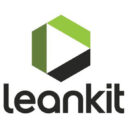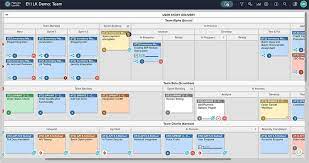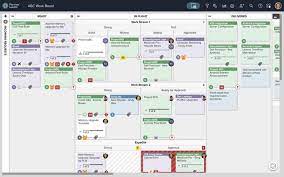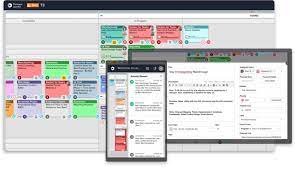ProjectLibre stands out as a powerful, free, and open-source project management software designed to simplify the planning, tracking, and control of projects. This versatile tool empowers users to create tasks, allocate resources, set deadlines, and monitor progress through visual aids such as Gantt charts and network diagrams.

In LeanKit, work items are presented by cards that move through distinct stages of the workflow. Each stage can have its own set of rules and policies, like limits on the number of cards in progress or the roles responsible for each stage.
LeanKit specifies real-time perceptibility into the status of work items, enabling teams to identify bottlenecks and modify their process accordingly. It further involves features like analytics, reporting, and integrations accompanying different tools.
- Visual Boards: LeanKit supplies a visual board that eases teams to path their work in real time. The board is customizable and can be configured to suit various workflows.
- Kanban Methodology: LeanKit is dependent on the Kanban methods, that target on continuous development, limit work in progress, and give value to clients.
- Card Management: Work items in LeanKit are presented by cards that can be moved across various stages of the workflow. The card management feature assigns team members to allocate tasks, add due dates, and path progress.
- Analytics and Reporting: LeanKit supplies real-time analytics and reporting to help teams identify bottlenecks, track growth, and measure accomplishment.
- Integration with different tools: LeanKit integrates with additional tools like JIRA, Trello, and Slack, composing it smooth for teams to collaborate and share information.
- Trello: Trello is a visual collaboration tool particularly dependent on the Kanban methods. It supplies an elementary and instinctive interface for building and supervising tasks.
- Asana: Asana is a project management tool that is concentrated on team collaboration. It presents features like task management, project tracking, and team communication.
- Jira: Jira is a well-known project management tool particularly widely used in software growth. It presents features like issue tracking, agile project management, and team collaboration.
- Basecamp: Basecamp is a project management tool that presents a concentered platform for team communication, file giving, and project tracking.
- Monday.com: Monday.com is a visual project management tool that assigns teams to accomplish tasks, workflows, and projects. It presents features like project tracking, collaboration, and automation.
LeanKit project management is specifically suitable for agile methodologies like Kanban. Its visual approach and adaptable workflow make it smooth for teams to control and prioritize tasks, limit work in progress, and constantly boost their process. LeanKit determines real-time visibility into the status of work items, enabling teams to collaborate efficiently and deliver high-quality work on time.
LeanKit project management for software development
LeanKit project management is generally used by software development teams due to its compatibility with agile methodologies like Kanban, and its capability to track and prioritize growth tasks. It allows teams to control their workflows capably, develop resources, and boost productivity while providing real-time visibility into project progress.
LeanKit project management for cross-functional teams
LeanKit project management is appropriate for cross-functional teams as it presents a visual and adaptable approach to controlling workflows. It approves teams to collaborate efficiently, appoint tasks, and path progress, regardless of their location or department. LeanKit’s customizable boards and analytics features make it smooth for cross-functional teams to control complicated projects and improve their processes.
LeanKit project management for project scheduling
LeanKit project management presents project scheduling features that approve teams to plan, schedule, and prioritize their tasks efficiently. Its Kanban-style boards allow teams to visualize their workflows, path progress, and control dependencies. LeanKit’s scheduling capacities supply real-time visibility into project timelines, helping teams to give projects on time and on budget.
LeanKit project management for task management
LeanKit project management is suitable for task management, as its Kanban-style boards supply a visual representation of tasks and their status. This makes it smooth for teams to control tasks, path progress, and collaborate efficiently. LeanKit’s customizable cards and reporting features further enable teams to improve their task management processes over time.
LeanKit project management for resource allocation
LeanKit project management proposes features for resource allocation that authorize teams to enhance their workflows and utilize their resources capably. Teams can use LeanKit to prioritize tasks, control work in progress, and allocate resources efficiently. Its analytics and reporting features determine real-time understandings of resource utilization, enabling teams to continuously upgrade their processes.
LeanKit project management for project budgeting
LeanKit project management presents project budgeting features that authorize teams to control their budgets efficiently. Teams can use LeanKit to plan and path project expenses, allocate resources capably and advance their workflows. LeanKit’s analytics and reporting feature supply real-time visibility into project costs, enabling teams to stay within budget and make knowledgeable conclusions.
LeanKit project management for project progress tracking
LeanKit project management is suitable for project progress tracking as it specifies real-time visibility into project rank. Teams can use LeanKit to path progress, control dependencies, and identify bottlenecks. Its Kanban-style boards and analytics features make it smooth to visualize project progress and improve workflows for upgraded productivity.
LeanKit project management for team collaboration and communication
LeanKit project management presents team collaboration and communication features that authorize teams to work together efficiently. Its Kanban-style boards and customizable cards manage easy-to-allocate tasks, path progress, and collaborate on work items. LeanKit’s real-time updates and reporting features further enable teams to communicate efficiently and create informed decisions.
LeanKit project management for visual project management
LeanKit project management is popular for its visual project management features. Its Kanban-style boards and customizable cards supply a clear and visual representation of project workflows and tasks. This authorizes teams to certainly prioritize tasks, path progress, and collaborate efficiently. LeanKit’s analytics and reporting features further provide real-time observations of project efficiency.

LeanKit is a project management tool that adopts a visual approach based on the Kanban method. Emphasizing visualizing workflows, restricting work in progress, and continuous improvement, LeanKit utilizes cards to represent work items that move through various stages of the workflow.
One essential difference is that LeanKit is generally focused on visual project management, accompanying its Kanban-style boards and customizable cards determining a clear and instinctive way to control tasks. Asana, nevertheless, presents a more established task list view, accompanying the choice to switch to a Kanban board or a timeline view.
LeanKit further has features that are tailored to agile methods like Kanban, building it a common choice for software growth teams. Asana, however, is more general-purpose and may be used by teams across a range of industries.
Both tools present collaboration features like task responsibilities, comments, and file attachments. Asana has a more expanded set of integrations accompanying additional tools and services, while LeanKit has stronger analytics and reporting features.
LeanKit project management vs Wrike
One main difference is that LeanKit is generally directed at visual project management, accompanying its Kanban-style boards and customizable cards giving a clear and instinctive way to control tasks. Wrike, however, proposes a more established task list view, accompanying the choice to switch to a board view or a Gantt chart view.
Another dissimilarity is that LeanKit is acknowledged for its support of agile methods like Kanban, composing it a well-known choice for software development teams. Wrike, nevertheless, presents a more extensive range of project management features that may be used across industries and project types.
Both tools propose collaboration features like task assignments, comments, and file attachments. Wrike has stronger project plan and resource management features, while LeanKit has more expanded analytics and reporting proficiencies.
LeanKit project management vs Basecamp
One key difference is that LeanKit is generally focused on visual project management, with its Kanban-style boards and customizable cards giving a clear and instinctive way to control tasks. Wrike, in another way, presents a more established task list view, accompanying the choice to switch to a board view or a Gantt chart view.
Another dissimilarity is that LeanKit is popular for its support of agile methods like Kanban, making it a well-known choice for software development teams. Wrike, however, offers a more extensive range of project management features that may be used across industries and project types.
Both tools present collaboration features like task assignments, comments, and file attachments. Wrike has stronger project plans and resource management features, while LeanKit has more considerable analytics and reporting capabilities.
ProjectManager.com emerges as a dynamic web-based project management software, offering teams the tools they need to plan, track, and collaborate on projects in real-time. This versatile platform encompasses a range of features, including task management, resource allocation, team communication, time tracking, and reporting.
ProWorkflow stands out as a cloud-based project management software designed to streamline project workflows for teams and businesses. It provides a comprehensive set of tools, including task management, time tracking, collaboration, invoicing, and reporting, to help organizations stay organized and efficient.






